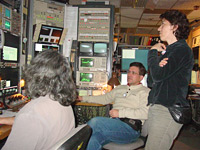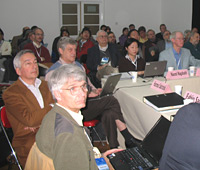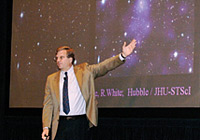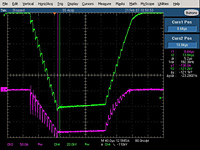Electron Cloud Studies Conducted at Cornell University

In the CESR control room, John Flanagan, KEK, Kathy Harkay, ANL, join Jerry Codner, Cornell (back to camera) in taking data on the electron cloud effect. Also participating in the measurements were Art Molvik, LLNL and Robert Holtzapple and Jamie Kern, Alfred University. |
In the end of January, the Laboratory for Elementary Particle Physics (LEPP) at Cornell University hosted collaborators from KEK, Lawrence Livermore National Laboratory, Argonne National Laboratory and Alfred University (an undergraduate University in New York State) to conduct electron cloud studies using the CESR storage ring. CESR is unique in that it is a “wiggler dominated” storage ring capable of storing intense beams of both electrons and positrons, singly or simultaneously.
Read more...
-- Maury Tigner, Cornell University |
 |
|
|
 |
Upcoming meetings, conferences, workshops
ILCDR07 - Damping Rings R&D Meeting
LNF-INFN, Frascati, Italy
5-7 March 2007
The LHC Early Phase for the ILC
Fermilab, Batavia, Illinois
12-14 April 2007
TESLA Technology Collaboration Meeting
Fermilab, Batavia, Illinois
23-26 April 2007
MAC Meeting
Fermilab
26-27 April 2007
DOE/NSF ILC Americas Regional Team Review
Fermilab
30 April - 2 May
Annual WILGA Conference
Warsaw University of Technology Resort, Poland
21-27 May 2007
 LCWS 2007 LCWS 2007
Hamburg, Germany
30 May - 4 June 2007
VII International workshop on Problems of Charged Particle Accelerators: Electron-positron Colliders
JINR-BINP, Alushta (Crimea, Ukraine)
2-8 September 2007
View Full Calendar...
|
|
 = Collaboration-wide Meetings = Collaboration-wide Meetings
GDE Meetings Calendar |
|
|
 |
International Review Panel Looks at ILC Detectors

Members of the committee reviewing the ILC detector tracking systems. |
The experiments will be the centre piece of the future ILC, and all the physics will revolve around them. They are being developed by sub-detector R&D and test-beam studies. The Worldwide Study (WWS) formed the Detector R&D Panel, headed by Chris Damerell, to review the activities and list missing topics. The panel has now started to hold regular reviews of the R&D projects. A dedicated committee will be formed for each sub-detector review, including external consultants, local experts, regional representatives and members of the panel. During the last ILC meeting in Beijing in February 2007, it reviewed the detector tracking systems.
Read more...
-- Perrine Royole-Degieux |
 |
|
|
 |
From Reuters
18 February 2007
Physicists dream of next big particle smasher
Read more... |
|
From Earth and Sky
18 February 2007
Will science find the "God particle"?
Read more... |
|
From PhysOrg.com
16 February 2007
Nobel laureate Burton Richter to speak about future of particle physics
Read more... |
|
From PhysOrg.com
14 February 2007
Smashing time: Physicists race to find dark matter and the 'God particle'
Read more... |
|
From El Pais
14 February 2007
El futuro colisionador lineal de partículas medirá 31 kilómetros
Read more... |
|
From Onversity
14 February 2007
International Linear Collider 2016 : Etudier l'univers
Read more... |
|
From NouvelObs.com
12 February 2007
Les physiciens dévoilent les plans du futur grand accélérateur de particules
Read more... |
|
|
 |
 |
|
|
 |
The Road to the ILC: Convincing our Colleagues

Jon Bagger presented the ILC at the AAAS annual meeting. |
Now that we have released our draft Reference Design Report for the ILC, our short-term focus is on completing and finalising the RDR. This will involve completing some unfinished work, undergoing international reviews and then revising and finalising the reference design and costing. We are scheduled to submit the report to the ILCSC and ICFA at their meetings this summer. We are also busy discussing and preparing for the engineering design phase and its associated R&D, which will require increased resources and some reorganisation of our efforts. The release of the RDR also increases the opportunities for us to explain the scientific motivation for developing the ILC as a future global science project. For example, we participated in a special session on future frontiers in particle physics organised at the annual meeting of the American Association for the Advancement of Science (AAAS) in San Francisco last week.
Read more...
-- Barry Barish
Director's Corner Archive |
 |
|
|
 |
Hot Off the Presses: Marx Modulator Milestone
 Yesterday morning a team led by Greg Leyh at SLAC successfully demonstrated the Marx modulator running at 120 kV (kilovolts) at a low pulse width. Later in the day, the team stretched the pulse out to 1.4 msec (milliseconds) at 100 kV. The Marx modulator is an ILC R&D programme at SLAC that eliminates the need for a massive transformer to raise the output voltage up to hundreds of kilovolts. “This is a most impressive and encouraging milestone for all who have worked so hard on it,” said SLAC’s Ray Larsen. “The Marx indeed looks promising to deliver a new era of intelligent, efficient high power electronics.” Look for more information about this milestone in upcoming issues of SLAC Today and ILC NewsLine.
Yesterday morning a team led by Greg Leyh at SLAC successfully demonstrated the Marx modulator running at 120 kV (kilovolts) at a low pulse width. Later in the day, the team stretched the pulse out to 1.4 msec (milliseconds) at 100 kV. The Marx modulator is an ILC R&D programme at SLAC that eliminates the need for a massive transformer to raise the output voltage up to hundreds of kilovolts. “This is a most impressive and encouraging milestone for all who have worked so hard on it,” said SLAC’s Ray Larsen. “The Marx indeed looks promising to deliver a new era of intelligent, efficient high power electronics.” Look for more information about this milestone in upcoming issues of SLAC Today and ILC NewsLine. |
 |
|
|
 |
ILC-Related Preprints
hep-ph/0702164
16 Feb 2007
Probing the lightest new gauge boson BH in the littlest Higgs model via the processes  at the ILC at the ILC
hep-ph/0702156
15 Feb 2007
Full one-loop electroweak corrections to  associated productions at e+e- linear colliders associated productions at e+e- linear colliders
hep-ph/0702124
12 Feb 2007
Searching for the Higgs boson |
|

